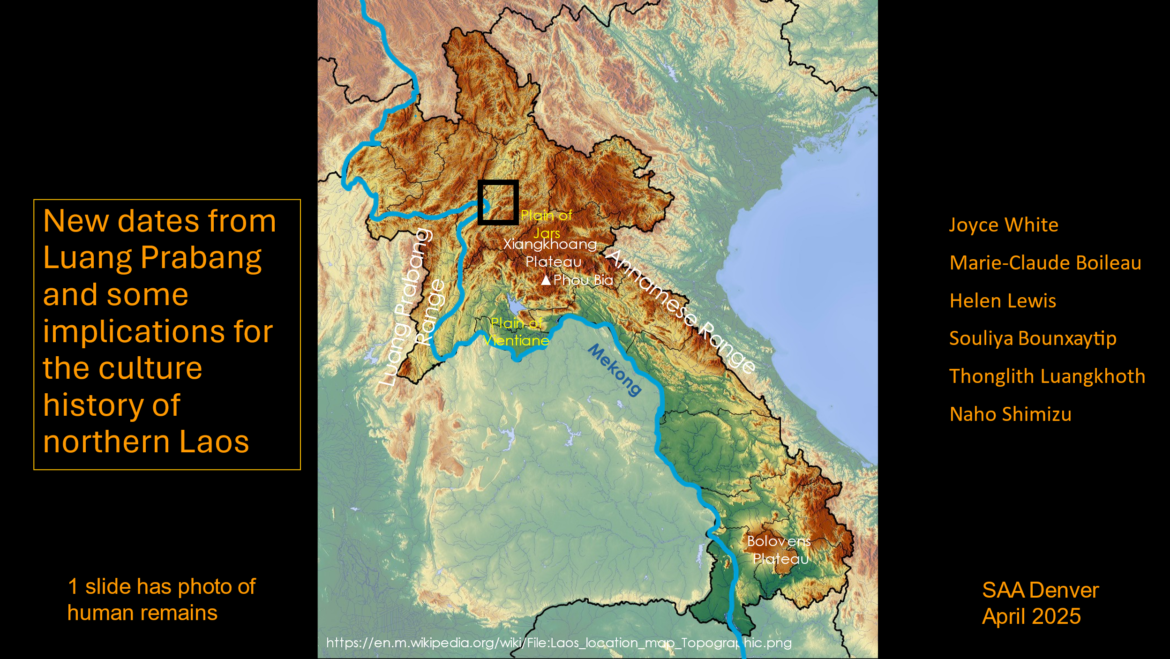Over the weekend, Drs. Joyce White and Elizabeth Hamilton gave paper presentations in the Denver Annual Meeting of the Society for American Archaeology.
Joyce presented at the Symposium: The Current State of Archaeological Research across Southeast Asia, and Elizabeth presented at Symposium: Archaeometallurgy, Eurasia, and Beyond: Papers in Honor of Vince Pigott.
You can find the abstracts below!
New dates from Luang Prabang and some implications for the culture history of northern Laos
By: Joyce White, Marie-Claude Boileau, Helen Lewis, Souliya Bounxaytip, Thonglith Luangkhoth, Naho Shimizu
The Middle Mekong Archaeological Project (MMAP) has investigated the archaeological record of Luang Prabang Province in northern Laos following an initial exploratory visit in 2001. A variety of research endeavors have since been undertaken, including surveys, test excavations at 4 cave/rockshelter sites, palaeoclimate research, and post-excavation studies. As can be expected for a research program in an under-investigated part of the world, data have emerged that have expanded understanding in new, unanticipated directions. For example, unpublished dates are associated with features and earthenware ceramic with possible links to the Plain of Jars phenomenon in northern Laos that imply an early historic period placement, which is more recent than previously proposed. These associations suggest that earthenware was produced into the historic period, and in fact the middle Mekong region currently has both earthenware and stoneware production localities. This paper will present these data, current interpretations, and how our research design explores emerging implications with expanded attention to ceramics. Images of some mortuary features include human remains.
High-Tin Bronze in Southeast Asia: Where Did It Come from, How Was It Made, and Who Used It?
By: Elizabeth Hamilton, Joyce White, and Thomas Pryce
One noteworthy feature of metallurgy in Southeast Asia is the appearance of quenched high-tin (tin between 20% and 30%) artifacts in the later 1st millennium BC. This intractable alloy cannot be worked cold but only hot-worked. Thin-walled (o.2-0.3mm) vessels of quenched high-tin bronze have been found at several sites in late first-millennium BC Mainland Southeast Asia. However, in two sites in northern northeast Thailand, Ban Chiang and Don Klang, quenched and hot-worked high-tin bronze artifacts are found only in fine (1 mm thick) wires that appear to have been used as necklaces, along with distinctive bangles. In neither site is there any evidence of the thin-walled vessels found elsewhere in MSEA. The distribution of vessels and fine wires is mutually exclusive: no sites with fine wires have vessels, and no sites with vessels have fine wires. Given the difficulty of working this alloy, especially to produce thin wires, we postulate the existence of a specialist wire- and bangle-producing and exchange industry that was responding to strong and distinctive local preferences.

